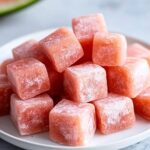The History of Jelly Desserts
Jelly, in its simplest form, is a gelatin-based dessert that has been enjoyed for centuries. The roots of jelly-like desserts can be traced back to ancient times, with the earliest versions being made from animal collagen. These early jellies were not as sweet as the ones we know today; they were often savory and used as a method of preserving food.
In the 19th century, the advent of commercial gelatin powders revolutionized jelly-making, making it easier for home cooks to prepare. By the early 20th century, sweet, fruit-flavored jellies became a staple at dessert tables, particularly in Western countries. Over time, creative bakers and chefs began experimenting with different flavors, colors, and textures, incorporating ingredients like chocolate, coffee, and even wine into their jelly recipes.
Chocolate jelly, however, is a more recent development in the world of jelly desserts. While traditional jellies were mostly fruit-based, chocolate jelly emerged as a modern twist, combining the rich flavor of chocolate with the unique, firm texture of gelatin. This combination resulted in a dessert that was not only visually appealing but also satisfying on multiple levels—rich in flavor, yet light in texture.
The Role of Agar in Jelly
One of the key ingredients that sets this chocolate jelly apart from traditional gelatin-based desserts is agar, a plant-derived substance that serves as the gelling agent. Agar is extracted from seaweed and has been used in Asian cuisine for centuries, particularly in Japan, where it is known as “kanten.” Unlike animal-based gelatin, which requires refrigeration to set, agar sets at room temperature, making it incredibly convenient for a variety of dessert applications.
Agar has several advantages over gelatin: it provides a firmer, more stable texture, and it can be used in recipes that require a longer shelf life. It is also naturally vegan and can be used by individuals with dietary restrictions. In this recipe, agar is dissolved in water and then mixed with the chocolate milk base, helping the dessert firm up into a jelly consistency while retaining a smooth and creamy texture. The result is a decadent, melt-in-your-mouth experience that is not as wobbly as traditional gelatin desserts but still incredibly satisfying.
Creating the Perfect Chocolate Milk Base
The foundation of any good chocolate jelly is the chocolate milk base. In this recipe, the combination of whole milk and chocolate creates a creamy, rich liquid that serves as the perfect canvas for the agar to work its magic. Whole milk is preferred for its richness and creaminess, which complements the deep, indulgent flavor of the chocolate.
Chocolate—whether dark, milk, or white—adds the signature sweetness and depth that chocolate lovers crave. The choice of chocolate plays a pivotal role in determining the overall flavor of the jelly. Dark chocolate, with its bittersweet taste, results in a more complex and slightly less sweet jelly. Milk chocolate, on the other hand, offers a milder, sweeter taste, while white chocolate contributes to a more delicate, creamy flavor.
The sugar added to the milk ensures the mixture has a balanced sweetness, though it can be adjusted to taste. For those seeking a lower-sugar option, alternatives such as honey or stevia can be used without compromising the dessert’s texture or taste.
The Magic of Combining Agar and Chocolate Milk
The process of combining the agar solution with the chocolate milk mixture is where the magic happens. Agar, once dissolved, is poured into the chocolate milk while stirring continuously. This step ensures that the agar is evenly distributed throughout the liquid, helping to achieve a smooth and consistent texture. After bringing the mixture to a boil, the result is a creamy, well-integrated base that is ready to set into a firm, jelly-like texture.
Unlike traditional gelatin, which can be temperamental when mixed with certain acidic ingredients, agar is much more stable, making it the ideal choice for this rich chocolate dessert. The boiling step is crucial, as it ensures that the agar fully dissolves and integrates with the chocolate milk base, preventing any clumps from forming.
Setting and Serving the Jelly
Once the agar-chocolate mixture is combined and thoroughly heated, it’s time to set the jelly. Pouring the mixture into molds, whether traditional jelly molds, silicone molds, or simple glass cups, allows you to create individual servings or a large, shareable dessert. The jelly should be allowed to cool to room temperature before being refrigerated for 2-3 hours until it’s fully set.
When serving, the chocolate jelly can be garnished with whipped cream, cocoa powder, berries, or grated chocolate for added texture and visual appeal. The contrast of the smooth, firm jelly with the lightness of whipped cream or the burst of fresh berries elevates the dessert to a whole new level of indulgence.
Nutritional Considerations and Dietary Flexibility
Chocolate jelly is a relatively light dessert compared to traditional chocolate cakes or mousses, making it a good option for those who want to satisfy their sweet cravings without overindulging. The use of whole milk in this recipe contributes to its creamy texture, but for those who follow a plant-based or dairy-free diet, the recipe can be easily adapted with a plant-based milk alternative, such as almond, soy, or oat milk.
Additionally, using agar as a gelling agent makes this recipe suitable for vegetarians and vegans, offering a great alternative to gelatin-based desserts. For those looking to reduce sugar intake, using natural sweeteners like honey or stevia allows for customization without sacrificing taste or texture.
Conclusion: A Unique Twist on Classic Chocolate Desserts
Chocolate jelly is a unique and delicious alternative to traditional chocolate desserts, offering a satisfying balance of flavor and texture. The combination of creamy chocolate milk with the firm, jelly-like consistency created by agar makes for a decadent treat that’s perfect for any occasion. Whether served as an elegant dinner party dessert or a simple indulgence for a weeknight treat, this chocolate jelly is sure to impress.
By using agar as the gelling agent and allowing room for customization with different types of chocolate and sweeteners, this recipe is both versatile and inclusive, catering to a variety of dietary preferences. With its smooth, silky texture and rich flavor, chocolate jelly is an exciting new way to enjoy the timeless pleasure of chocolate desserts.






